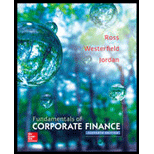
Case synopsis:
Company B has been planning for the past 6 months to merge with Company H. After few discussions, it has decided to make a cash offer of $250 million for Company H. Person B, the financial officer of Company B, has been involved in the negotiations of merger.
He has prepared a pro forma financial statements for Company H assuming that the merger will take place. If Company B purchases Company H, then there will be an immediate payment of dividend. Person B has identified the interest rate of borrowing for both the companies.
Characters in the case:
- Company B
- Company H
- Person B
Adequate information:
- Both the companies are planning to merge have niche markets in the industry of golf club.
To calculate: Whether Company B must continue with the merger if the shareholders of Company H agree at a price of $31.25 per share.
Answer to Problem 1M
The
Explanation of Solution
Given information:
Company H will have a cash offer of $250 million for the merger. The dividend of $67.5 million will be paid from Company H to Company B, if Company B buys Company H. The sale price of the stock in Company B is $87 per share and its outstanding shares are 8 million. The rate of interest at which both the company could borrow is 8%.
The present capital cost for Company B and Company H are 11% and 12.4% respectively. The equity cost is 16.9%. Within five years, Company H’s value is projected to be $270 million.
Note: It is necessary to find the present value of incremental cash flow to do a merger analysis. Hence, compute the total cash flow at present from the acquisition.
Explanation:
Formula to calculate the total present cash flow from the acquisition:
Calculate the total present cash flow from the acquisition:
Hence, the present cash flow is -$182,500,000.
Formula to compute the dividend from Company H:
Compute the dividend from Company H:
Hence, the dividend in Year 1 is $20,700,000.
Hence, the dividend in Year 2 is $5,000,000.
Hence, the dividend in Year 3 is $13,500,000.
Hence, the dividend in Year 4 is $19,950,000.
Hence, the dividend in Year 5 is $27,000,000.
Table showing the total cash flow:
| Total cash flow | Year 1 | Year 2 | Year 3 | Year 4 | Year 5 |
| Dividends from Hybrid | $20,700,000 | $5,000,000 | $13,500,000 | $19,950,000 | $27,000,000 |
| Terminal value of equity | $270,000,000 | ||||
| Total | $20,700,000 | $5,000,000 | $13,500,000 | $19,950,000 | $29,700,000 |
It is necessary to discount every cash flow at the appropriate rate of discount. The company’s terminal risk is subjected to the normal business risk and must be discounted at the capital cost. The dividends must be discounted at the equity cost.
Formula to compute the discounted dividend:
Where,
t denotes the number of years.
Compute the discounted dividend:
Hence, the discounted dividend for Year 1 is $17,707,442.
Hence, the discounted dividend for Year 2 is $3,658,819.
Hence, the discounted dividend for Year 3 is $8,450,652.
Hence, the discounted dividend for Year 4 is $10,682,794.
Hence, the discounted dividend for Year 5 is $12,367,765.
Formula to compute the present value of the terminal value of equity:
Where,
t denotes the number of years.
Compute the present value of the terminal value of equity:
Hence, the present value of the terminal value of equity is $150,498,513.
Table showing the present values of the cash flows:
| Discount rate | Year 1 | Year 2 | Year 3 | Year 4 | Year 5 | |
| Dividends | 16.90% | $17,707,442 | $3,658,819 | $8,450,652 | $10,682,794 | $12,367,765 |
| PV of terminal value | 12.40% | $150,498,513 | ||||
| Total | $17,707,442 | $3,658,819 | $8,450,652 | $10,682,794 | $162,866,277 |
Formula to calculate the NPV of the acquisition:
Calculate the NPV of the acquisition:
Hence, the NPV of the acquisition is $20,865,984.
Want to see more full solutions like this?
Chapter 26 Solutions
Fundamentals of Corporate Finance
 Financial Reporting, Financial Statement Analysis...FinanceISBN:9781285190907Author:James M. Wahlen, Stephen P. Baginski, Mark BradshawPublisher:Cengage Learning
Financial Reporting, Financial Statement Analysis...FinanceISBN:9781285190907Author:James M. Wahlen, Stephen P. Baginski, Mark BradshawPublisher:Cengage Learning EBK CONTEMPORARY FINANCIAL MANAGEMENTFinanceISBN:9781337514835Author:MOYERPublisher:CENGAGE LEARNING - CONSIGNMENT
EBK CONTEMPORARY FINANCIAL MANAGEMENTFinanceISBN:9781337514835Author:MOYERPublisher:CENGAGE LEARNING - CONSIGNMENT Intermediate Financial Management (MindTap Course...FinanceISBN:9781337395083Author:Eugene F. Brigham, Phillip R. DavesPublisher:Cengage Learning
Intermediate Financial Management (MindTap Course...FinanceISBN:9781337395083Author:Eugene F. Brigham, Phillip R. DavesPublisher:Cengage Learning





